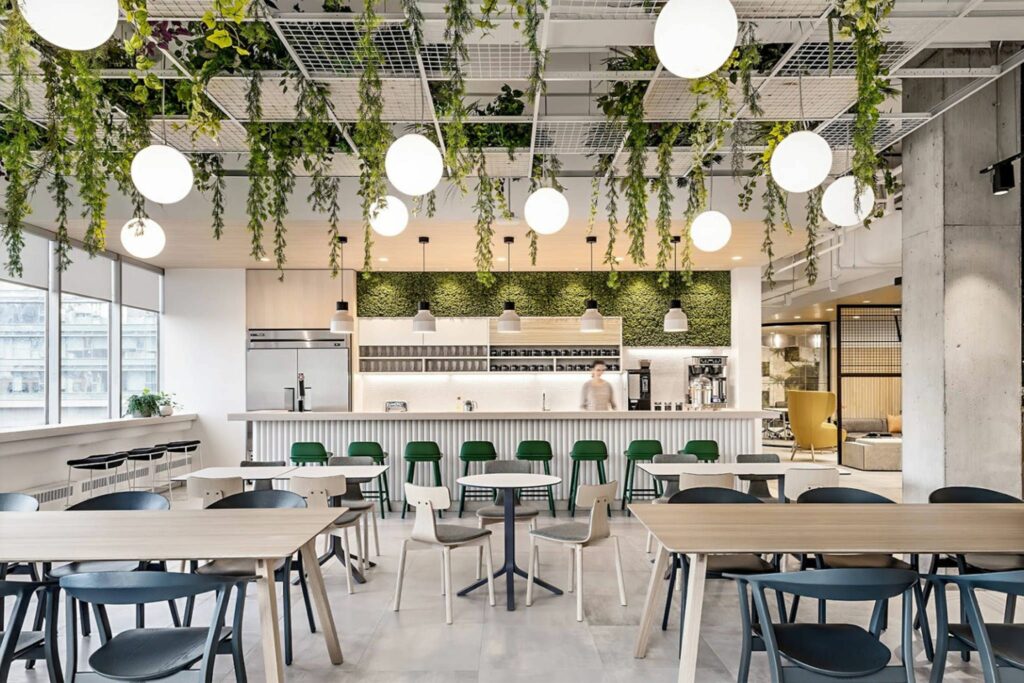
Co-working spaces have revolutionized the way people work, providing shared environments that foster collaboration, innovation, and productivity. These spaces are purposefully designed to accommodate professionals from various industries, offering flexible workstations, amenities, and a vibrant community. In recent years, co-working spaces also called Social spaces or community cente have gained immense popularity in Real Estate, transforming the real estate landscape. With the rise of remote work and the changing preferences of modern professionals, these spaces have become a beacon of flexibility and convenience. As a result, the demand for co-working spaces has surged, leading to significant impacts on the real estate industry.
The purpose of this article is to delve into the phenomenon of co-working spaces, examining its various aspects and shedding light on the implications it has on the real estate industry. By analyzing the drivers behind this trend, exploring its impact on the commercial real estate sector, and discussing the benefits, challenges, and future prospects, we can better understand the significance of co-working spaces in today’s work environment.
Understanding Co-Working Spaces
Co-working spaces are shared work environments where individuals, freelancers, entrepreneurs, and even remote employees of established companies can work independently or collaboratively. These spaces provide a dynamic setting that encourages networking, knowledge sharing, and creativity.
These spaces have a fascinating history that traces back to the early 2000s when freelancers and entrepreneurs sought alternatives to traditional office settings. The concept gained traction as individuals recognized the benefits of working alongside like-minded professionals in a supportive and communal atmosphere.
Social spaces prioritize the needs of modern professionals by providing a range of amenities. These include high-speed internet, comfortable workstations, meeting rooms, communal areas, kitchen facilities, and often additional perks such as complimentary refreshments, event spaces, and access to professional networks.
Drivers of the Co-Working Space Trend
The co-working space trend is driven by a shift in work culture, with remote work becoming increasingly prevalent. Professionals are seeking flexible work arrangements, enabling them to escape the confines of traditional office environments. Co-working spaces cater to this desire, offering a productive alternative that aligns with modern workstyles.
Technological advancements have been pivotal in facilitating the growth of co-working spaces. Seamless connectivity, cloud computing, and collaborative tools have empowered individuals to work remotely and collaborate effortlessly with colleagues and clients. Co-working spaces leverage these technologies to create environments conducive to productivity and innovation.
One of the primary attractions of co-working spaces is the flexibility they provide. Startups, small businesses, and independent professionals can avoid long-term leases and the financial burden of establishing their own offices. Instead, they can opt for short-term memberships or pay-as-you-go options, significantly reducing overhead costs.
Co-working spaces foster a sense of community and collaboration, offering professionals the chance to connect, network, and collaborate with like-minded individuals from diverse backgrounds. The opportunity to exchange ideas, share knowledge, and collaborate on projects is a major driver for professionals seeking a co-working environment.
Impact on the Real Estate Industry
Co-working spaces have had a profound impact on the real estate industry, transforming the way commercial properties are utilized and creating new opportunities for both developers and tenants.
Transformation of Commercial Real Estate Landscape
Co-working spaces have disrupted the traditional commercial real estate market. The demand for large office spaces has diminished as companies opt for more flexible alternatives. This has prompted a shift in the real estate sector, with developers and landlords adapting their strategies to cater to the co-working trend.
Revitalization of Underutilized Properties
Abandoned warehouses, historical buildings, and underutilized properties have found new life as co-working spaces. These spaces inject vitality into previously neglected areas, revitalizing neighborhoods and contributing to urban renewal initiatives. The adaptive reuse of such properties aligns with sustainability goals and fosters creativity through unique architectural and design elements.
Influence on Office Design and Layout Trends
Co-working spaces have had a profound impact on office design trends. The emphasis on open layouts, flexible workstations, and collaborative areas has influenced traditional office spaces as well. Employers are increasingly incorporating elements of co-working spaces into their own offices to create more dynamic, engaging, and employee-friendly environments.
Challenges and Opportunities for Traditional Office Spaces
The rise of co-working spaces poses challenges and opportunities for traditional office spaces. The demand for traditional long-term leases has decreased, requiring office landlords to adapt their strategies to remain competitive. On the other hand, companies that require privacy, specialized infrastructure, or larger spaces may continue to opt for traditional offices, presenting an opportunity for landlords to cater to these specific needs.
Types of Co-Working Spaces
Each type of co-working space caters to different needs and preferences, offering unique benefits and opportunities for individuals and businesses. The different types of co-working spaces are:
Shared Co-Working Spaces
Shared co-working spaces are the most common and well-known type of co-working environments. These spaces offer a shared work area where individuals from different companies or industries work side by side.
Shared co-working spaces provide a range of amenities such as open desks, private offices, meeting rooms, communal areas, and access to basic office equipment. They foster a sense of community and collaboration among members, encouraging networking and knowledge sharing.
Industry-Specific Co-Working Spaces
Industry-specific co-working spaces cater to professionals working within a specific sector or niche. These spaces are designed to meet the unique needs and requirements of a particular industry.
For example, there are these kind of spaces specifically tailored for tech startups, creative professionals, healthcare practitioners, or media professionals. Industry-specific co-working spaces often provide specialized equipment, resources, and networking opportunities relevant to that industry, creating a focused and supportive work environment.
Corporate Co-Working Spaces
Corporate co-working spaces are dedicated workspaces created by established companies for their own employees. These spaces provide a flexible and collaborative work environment within the company’s premises, encouraging cross-departmental collaboration, innovation, and employee engagement.
Corporate co-working spaces often include a mix of open work areas, meeting rooms, and breakout spaces designed to foster creativity and teamwork. They offer employees the benefits of a co-working environment while maintaining a connection to the company’s culture and resources.
Co-living and Co-Working Hybrid Spaces
Co-living and co-working hybrid spaces combine residential accommodations with co-working facilities. These spaces cater to individuals seeking a complete lifestyle solution, where they can live and work within the same environment.
Co-living and co-working hybrid spaces often feature private bedrooms or shared apartments, along with dedicated work areas, communal spaces, and amenities such as kitchens, gyms, and social areas. They provide a convenient and integrated solution for digital nomads, freelancers, and remote workers who prioritize convenience, community, and work-life balance.
Benefits and Challenges of Co-Working Spaces
Co-working spaces offer numerous benefits for individuals and businesses alike, but they also come with their own set of challenges. Understanding these advantages and potential drawbacks is essential for anyone considering co-working as an option.
Benefits for Individuals and Businesses
Co-working spaces offer numerous benefits for both individuals and businesses, contributing to their popularity and appeal.
Networking and Collaboration: Co-working spaces create opportunities for professionals to network, collaborate, and build meaningful connections. The diverse community within these spaces facilitates knowledge sharing, skill exchange, and potential business partnerships.
Flexibility and Cost-Effectiveness: Social spaces provide flexible membership options, allowing individuals and businesses to choose plans that suit their specific needs. This flexibility eliminates the need for long-term leases and reduces overhead costs associated with setting up and maintaining a traditional office space.
Access to Amenities and Resources: These community centers offer a range of amenities such as high-speed internet, meeting rooms, printing facilities, and communal areas. These resources are readily available to members, eliminating the need for individuals and businesses to invest in their own infrastructure.
Enhanced Productivity and Focus: Co-working spaces provide a dedicated work environment away from distractions. The structured setting and professional atmosphere can boost productivity and focus, particularly for remote workers and freelancers who may struggle with the isolation of working from home.
Professional Image: Social spaces offer a professional setting for meetings, client interactions, and hosting events. This allows individuals and startups to project a polished and credible image to clients and partners, even if they do not have a traditional office space of their own.
Challenges and Considerations for Co-Working Space Operators
While co-working spaces bring significant benefits, operators must also navigate several challenges to ensure their success and sustainability.
Community Management: Fostering a strong community within a co-working space requires effective community management. Co-working space operators need to facilitate connections among members, organize networking events, and address any conflicts that may arise.
Space Utilization and Management: These spaces must strike a balance between providing sufficient space for members and managing occupancy levels to avoid overcrowding. Effective space utilization and management ensure that members have access to amenities and can work comfortably.
Privacy and Security: These spaces often involve shared areas and open workspaces, which may raise concerns about privacy and data security. Co-working space operators must implement measures to protect sensitive information. And Also to create private areas for individuals or businesses requiring additional confidentiality.
Maintenance and Operations: Social spaces require regular maintenance and operational management to provide a clean, functional, and well-equipped environment. This includes managing facilities, and equipment, and ensuring a comfortable workspace for members.
Member Retention and Satisfaction: Retaining members and ensuring their satisfaction is crucial for the long-term success of a co-working space. Operators need to continuously assess and meet the evolving needs of their members, providing a positive and supportive work environment.
Co-Working Space Models and Providers
There are various models and providers in the co-working space industry, each offering unique approaches and services to cater to the diverse needs of professionals. Understanding these models can help individuals and businesses find the right co-working space that aligns with their requirements and preferences.
Independent Co-Working Spaces
Independent co-working spaces are standalone facilities operated by independent companies or individuals. These spaces are often driven by a specific vision or mission and create their own unique atmosphere and community.
Independent community center spaces have the freedom to design their space, amenities, and membership options according to their target audience. They are known for their entrepreneurial spirit and flexibility in adapting to the evolving needs of their members. Independent social spaces can range in size from small, niche-focused locations to larger spaces that cater to a broader audience.
Co-Working Franchises and Chains
Co-working franchises and chains operate multiple Social spaces under a unified brand. These models offer consistency across different locations, providing members with the benefit of a familiar experience regardless of where they choose to work.
Franchise and chain co-working spaces often have established systems and processes, ensuring a standardized level of service and amenities. They may offer membership plans that allow individuals to access multiple locations, making it convenient for frequent travelers or those seeking flexibility in their work arrangements.
Co-Working Spaces Within Established Companies
Many established companies have recognized the value of these spaces and have integrated them into their own operations. These companies allocate space within their offices or create dedicated co-working areas for their employees.
This model combines the benefits of a traditional office environment with the flexibility and collaborative atmosphere of a co-working space. Co-working spaces within established companies can foster cross-departmental collaboration, knowledge sharing, and innovation among employees while maintaining a connection to the company’s culture and resources.
Future Trends and Innovations
The co-working space industry is constantly evolving, driven by technological advancements, changing work patterns, and the evolving needs of professionals. As the industry continues to grow, several future trends and innovations are shaping the co-working landscape.
Integration of Technology for Enhanced Productivity
Technology plays a crucial role in co-working spaces, and its integration will continue to shape the industry. Innovations such as smart office solutions, Internet of Things (IoT) devices, and advanced connectivity infrastructure will enhance the productivity and convenience of co-working spaces.
This includes features like automated booking systems for meeting rooms, smart access control, seamless wireless connectivity, and integrated communication platforms. The integration of technology will streamline operations, improve member experience, and enable efficient collaboration.
Sustainability and Eco-Friendly Initiatives in Co-Working Spaces
With the growing emphasis on sustainability and environmental responsibility, co-working spaces are incorporating eco-friendly practices and initiatives. This includes the use of renewable energy sources, energy-efficient lighting, recycling programs, and the implementation of sustainable building materials.
Social spaces are also focusing on creating wellness-centered environments with green spaces, natural lighting, and improved indoor air quality. These sustainability efforts not only align with global environmental goals but also enhance the overall experience and well-being of co-working space users.
Hybrid Models Combining Physical and Virtual Co-Working
The emergence of remote work and the increasing reliance on virtual collaboration tools have paved the way for hybrid co-working models. These models combine the benefits of physical co-working spaces with virtual platforms. Which enables individuals to work remotely while still being part of a vibrant co-working community.
Hybrid models offer flexible membership options that provide access to physical spaces on-demand while also offering virtual networking events, online communities, and digital collaboration platforms. This integration of physical and virtual co-working experiences allows professionals to seamlessly transition between different work environments based on their needs and preferences.
Conclusion

These Social spaces have emerged as a new trend in the real estate industry, driven by changing work cultures, technological advancements, and the need for flexibility and cost-effectiveness. These shared work environments offer individuals and businesses a range of benefits, including networking opportunities, increased productivity, and reduced overhead costs.
Looking ahead, the co-working space industry is poised for further growth and innovation. Integration of technology, sustainable practices, and hybrid models combining physical and virtual co-working are expected to shape the future of these spaces. As the demand for flexible work arrangements continues to rise, there will be opportunities for both independent co-working spaces. And also established companies to adapt and expand their offerings.
These spaces have transformed the real estate landscape, challenging traditional office setups and revitalizing underutilized properties. They have provided a solution for professionals seeking flexibility, collaboration, and community. By fostering a sense of connection and providing a platform for knowledge sharing. In all, Social spaces have become an integral part of the modern work ecosystem.
Want to know, How and Where to Invest in Office spaces in Noida Click here.

